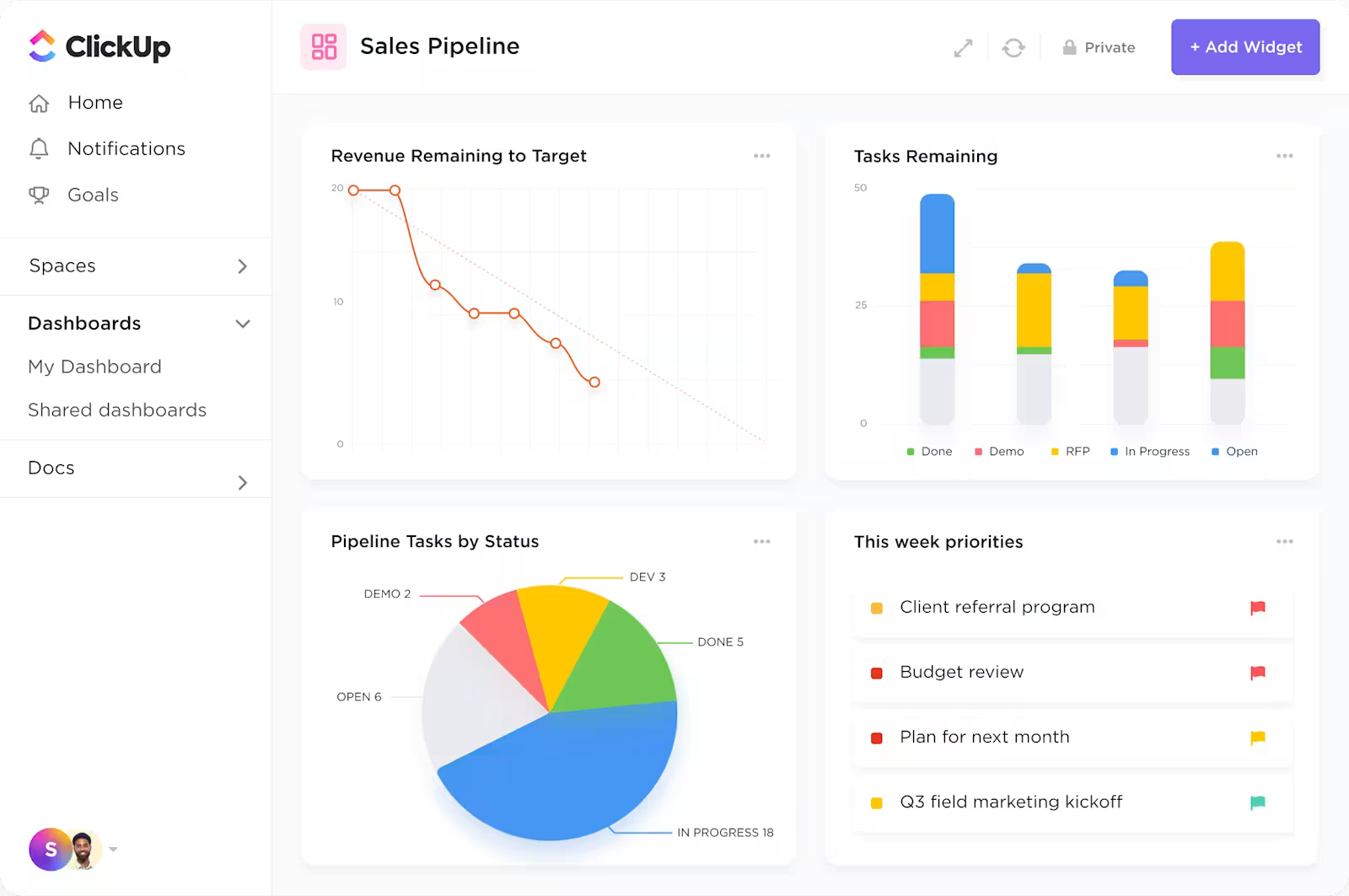ثلاثة مليارات قرار في السنة: هذا هو كم عدد القرارات المديرين والمديرين التنفيذيين كجزء من عملهم اليومي.
يعد اتخاذ القرارات جزءًا مهمًا من وظيفة كل مدير، ومع ذلك فإن معظمهم لا يقومون بعمل جيد في ذلك. فهم يعتمدون على الغريزة والحدس في اتخاذ القرارات، حيث لا يستفيد 98% منهم من أفضل الممارسات.
يمكن أن يكون للقرارات السيئة عواقب وخيمة على المؤسسة، مثل الأداء المالي السيئ (التكلفة 3% من الأرباح السنوية !)، وفقدان السمعة، ودوران الموظفين، ومشاكل الامتثال، وما إلى ذلك. يمكن للقرارات السليمة أن تمنع حدوثها.
في منشور المدونة هذا، دعنا نرى كيف يمكنك استخدام أنماط اتخاذ القرارات الأربعة الشائعة الاستخدام لاتخاذ قرارات أفضل في مجال الأعمال.
ما هي أنماط اتخاذ القرارات؟
أنماط اتخاذ القرار هي الأساليب التي تتبعها كمدير لحل مشكلة ما أو تحسين عملية ما أو حل نزاع ما. يعتمد نهجك على المشكلة المطروحة وضيق الوقت وقيود الموارد والعديد من المتغيرات الأخرى.
عندما نتحدث عن القرارات، فإننا لا نعني فقط القرارات الكبيرة مثل استراتيجية التسويق للعام أو فصل موظف غير كفء. فقد تكون أيضًا الأمور التي تبدو غير مهمة مثل سطر الموضوع في رسالة بريد إلكتروني أو الوقت المناسب لاجتماع واحد على واحد.
إن بناء أساليب مدروسة وقابلة للتكرار في اتخاذ القرارات يمكن أن يغير قواعد اللعبة بالنسبة لشخص يتخذ آلاف القرارات يومياً. ومع ذلك، قبل أن تبني
عملية اتخاذ القرار
، من الضروري أن تأخذ بعين الاعتبار مناهج فريقك وتفضيلاته وشخصياته وردود أفعاله.

فهم أنماط اتخاذ القرار في فريقك
_الناس لا يتركون المؤسسات. بل يتركون المديرين
كل قرار تتخذه له تأثير على فرقك وزملائك. لذا، قبل أن تطور أسلوبك، من الضروري أن تفهم أسلوبهم.
1. افهم فريقك
تحدث إلى أعضاء فريقك لفهمهم كأفراد. شجعهم على التحدث عن أولوياتهم وتفضيلاتهم. على سبيل المثال، إذا كنت تتخذ قرارات بشأن استراتيجية عملك المختلط، افهم
- ما هي المناطق الزمنية التي يعيشون فيها
- ما هو الوقت الذي يحبون العمل فيه
- متى يمكنهم تلقي المكالمات
- هل لديهم أطفال يقومون بتوصيلهم/إصطحابهم من المدرسة
لا توجد معلومة تافهة للغاية. إن فهم دوافع كل فرد وشغفه وشخصيته بشكل عام يساعد المديرين على معرفة كيفية إدارته.
2. راقب فريقك
لا يتحدث الجميع بنفس الطريقة. قد لا يتحدث بعض أعضاء الفريق. لذا، راقب أساليبهم في اتخاذ القرارات على مدى فترة من الزمن. عندما تعرف كيف يتخذون قراراتهم، يمكنك محاكاة أساليبهم للتأثير عليهم.
- هل يقدمون بيانات ملموسة في المراجعات الشهرية؟ هذا يدل على أنهم يركزون على البيانات الموضوعية
- هل يأتون إليك بانتظام للحصول على اقتراحاتهم؟ هل يبحثون عن توافق في الآراء والتحقق من صحة ذلك
- هل يغيرون عملياتهم الشخصية كل شهرين؟ قد يكونون متسرعين أو موجهين نحو العمل، أو تجريبيين بطبيعتهم
3. تقييم فريقك
هناك العشرات من الطرق المجربة لفحص وفهم أنماط اتخاذ القرار لدى فريقك. إن مؤشر نوع مايرز بريجز (MBTI) يساعد في تحديد التفضيلات الطبيعية للفرد في أربعة جوانب من الشخصية.

ملف تعريف نمط القرار
شركاء التأثير الملف الشخصي لنمط القرار يقيم الأشخاص في خمسة عوامل رئيسية: الوضوح والمعلومات والالتزام والمواءمة والوقت. الصدق اختبار أسلوب اتخاذ القرار يستكشف كيفية ترتيب أولوياتك للأهداف المختلفة وكيفية تأثيرها على قراراتك.
يمكن أن يمنحك استخدام أي من هذه الأدوات فكرة أوضح عما يحرك فرقك. ومع ذلك، من المهم ملاحظة أن هناك بعض المخاوف القانونية حول استخدام اختبارات الشخصية في مكان العمل. ضع في اعتبارك القوانين الفيدرالية وقوانين الولاية والقوانين المحلية قبل اختيار أحدها.
والآن بعد أن انتهيت من فرز الأسس التي تقوم عليها، دعنا نستكشف أنماط اتخاذ القرار الأربعة وكيف يمكنك الاستفادة منها في العمل.
4 أنماط مختلفة لصنع القرار ## 4 أنماط مختلفة لصنع القرار
1. توجيهي
يفضل أسلوب اتخاذ القرار التوجيهي استخدام المعلومات المعروفة بالفعل والاتجاهات السابقة لاختيار المسارات المستقبلية. وهو عقلاني وقائم على البيانات ومنطقي. يختار صانعو القرارات التوجيهية ما يلي:
- اتخاذ القرارات بأنفسهم
- استخدام البيانات والإجراءات السابقة بدلاً من تجربة طرق جديدة
- إعطاء الأولوية لسرعة اتخاذ القرار
- أن يكونوا مباشرين في عملية تفكيرهم
- تجنب الغموض
يعد اتخاذ القرارات التوجيهية مثاليًا للقرارات السريعة أو المتكررة أو قصيرة المدى. كما أنه مثالي للمواقف التي يكون فيها الهدف واضحًا. قبل اتخاذ القرارات، جرّب ما يلي قالب تحديد الهدف للبدء بشكل صحيح
بمجرد تحديد الهدف، سيصبح جمع البيانات وتحليلها أسهل. على سبيل المثال، إذا كنت مدير مشروع تقوم بتقدير الوقت لكل مهمة، فإن اتخاذ القرارات التوجيهية يوفر الكثير من الوقت مع الدقة تقريبًا.
![]()
عرض تعقب الوقت على ClickUp لإجراء تقديرات للمهام المتشابهة
يمكن أن يُنظر إلى هذا أحيانًا على أنه غير تعاوني أو موثوق. لذلك، فهي غير مناسبة للقرارات الكبيرة أو التغييرات التي تؤثر على حياة الناس.
لنفترض أنك مدير موارد بشرية مسؤول عن استراتيجية العمل عن بُعد. إذا اتخذت قراراً بأن الناس بحاجة إلى الحضور إلى المكتب من الاثنين إلى الجمعة من الساعة 9-6 من يوم الاثنين حتى يوم الجمعة، فسيُنظر إليه على أنه غير مرن وغير مرحب به، حتى لو بنيته على أساس التفكير العقلاني والبيانات.
هذا النوع من اتخاذ القرارات غير مناسب أيضًا إذا كنت تدير موظفين ذوي مهارات عالية ومستقلين ويريدون حرية الإبداع. فهم لن يقدروا أن يُملى عليهم ما يجب عليهم فعله.
2. تحليلي
أسلوب القرار التحليلي هو أسلوب استكشافي. هنا، تنظر في جميع الحقائق والآراء والسيناريوهات المحتملة والمخاطر والتكاليف والعواقب قبل اتخاذ القرار. كما أنك تأخذ الوقت الذي تحتاجه.
يتم استخدام الأسلوب التحليلي في اتخاذ القرار عندما تكون هناك خيارات متعددة، ولا يوجد شيء اسمه "إجابة واحدة صحيحة"
على سبيل المثال، إذا كنت مدير المشتريات المكلّف بشراء إدارة المشروع أداة للفريق الهندسي، ستتبع نهجًا تحليليًا في اتخاذ القرارات. سيقوم صانعو القرارات التحليلية بـ
- استكشاف جميع الأدوات المتاحة
- وضع قائمة مختصرة بالأدوات المحتملة بناءً على الميزات والفوائد
- مقارنة السعر وسهولة الاستخدام
- دراسة شروط العقد وشروطه وسياسات تجديده
- التفاوض على الخصومات والصفقات مع البائعين
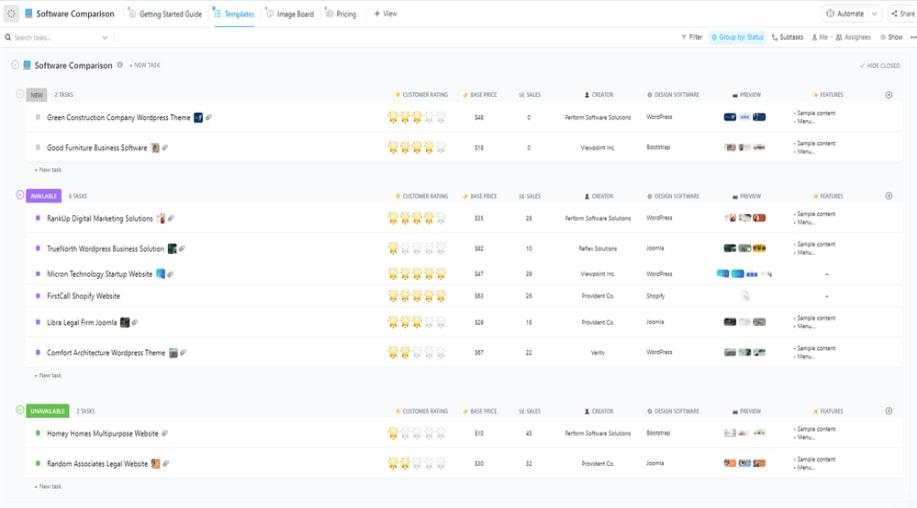
قالب مقارنة برامج ClickUp
نهج تحليلي لاتخاذ القرار يساعدك على الموازنة بين خياراتك واختيار الأنسب لك، بناءً على المعلومات المتاحة.
كما أن أسلوب اتخاذ القرار التحليلي لا يتيح مساحة كبيرة للغموض. ولكي تكون تحليلياً، من الضروري أن تكون جميع المعلومات في متناول يدك بوضوح. في بعض الأحيان، قد تكون معلوماتك الخاصة. لذلك، فإنه ينطبق على القرارات المعقدة، فقط إذا كانت الخيارات/الاحتمالات محددة بوضوح.
وهو ليس النهج الصحيح إذا كان القرار ينطوي على الكثير من المتغيرات أو عدم القدرة على التنبؤ، مثل مشاعر أعضاء الفريق. وهو بالتأكيد غير مناسب للمشاكل التي تحتاج إلى حل فوري.
3. المفاهيمي
ينطوي اتخاذ القرارات بالأسلوب المفاهيمي على نهج إبداعي لحل المشكلات. عندما تكون هناك مشكلة معقدة تنطوي على تخيل سيناريوهات محتملة مختلفة والتوصل إلى حلول مبتكرة، فإن هذا هو الأسلوب الأفضل.
صانعو القرار المفاهيمي:
- يحبون المخاطرة
- يقدرون الإبداع على العمليات المحددة مسبقاً
- طرح الأسئلة المفتوحة واستكشاف الاحتمالات
- التفكير بشكل كلي، بما في ذلك العواقب العرضية
- المرونة عند مواجهة الاحتمالات الجديدة
لنأخذ مثالاً لمدير منتج يصمم خارطة طريق لبرمجياته. عملية اتخاذ القرار هذه مثالية. سيبدأون بتوثيق احتياجاتهم، ثم يتعاونون على السبورة البيضاء، ويجرون استطلاعات الرأي للحصول على الملاحظات، ويجرون تخطيط السيناريوهات، قبل اتخاذ القرار.
أما صانع القرار المفاهيمي فهو متعاون وسيجمع الفريق بأكمله معًا لابتكار عملية اتخاذ القرار. إنه يحفز الفريق على الإبداع والنظر في التأثيرات طويلة المدى.
يعد أسلوب اتخاذ القرار المفاهيمي رائعًا في المواقف المعقدة والغامضة؛ وهو غير مناسب للقرارات الصغيرة أو البسيطة. إذا بدأت بسحب السبورة البيضاء وإشراك المجموعة في اتخاذ القرارات الجماعية من أجل "أين نذهب لتناول غداء الفريق؟
4. السلوكيات
إذا كنت تتبع نهجًا يركز على الأشخاص في كل قرار، فأنت تتبع أسلوبًا سلوكيًا في اتخاذ القرارات. في هذا الأسلوب، سوف:
- تأخذ بعين الاعتبار مشاعر فريقك وعواطفه
- دعوة المشاركة الفعالة من كل عضو في الفريق
- التأثير على قرارات الأشخاص ببطء وتروٍّ في اتخاذ القرارات
- إعطاء الأولوية لمنفعة الكثيرين على القلة
يتم اتباع هذا الأسلوب بشكل شائع في فرق الموارد البشرية أو فرق إدارة الأفراد. يستخدم مديرو المشاريع هذا الأسلوب أيضاً أثناء اتخاذ القرارات النهائية التي قد تكون معطلة أو غير سارة.
عند إنهاء عقد أحد البائعين، أو فصل أحد الموظفين، أو تغيير هياكل الفريق، وما إلى ذلك، فإن هذا الأسلوب يعمل بشكل أفضل.
ومع ذلك، فإن المدراء الذين يتبعون أسلوب اتخاذ القرار المفاهيمي يواجهون خطر الاهتمام الزائد بمشاعر/ردود أفعال الناس، مما يؤثر على قرارهم نفسه. كما أن التركيز الشديد على بناء الإجماع قد يؤدي أيضاً إلى تأخيرات مفرطة وسخط أعضاء الفريق. وجود أهداف التواصل مهم أيضًا، مع اتباع هذا النهج.
كما ترى، لا يوجد أسلوب صحيح أو خاطئ في اتخاذ القرار. واعتمادًا على الموقف والعواقب، قد يعمل أحد الأساليب بشكل أفضل من الأساليب الأخرى. وسيتعلم المدير الجيد جميع الأساليب ويطبقها حسب الاقتضاء طوال حياته المهنية.
مهما كان الأسلوب الذي تختار اتباعه، يمكنك الاستفادة من الأدوات والتقنيات المختلفة لاتخاذ القرارات الصحيحة. دعنا نرى كيف.
كيف تدير أنماط اتخاذ القرار في فريقك
ستمنحك أداة جيدة لإدارة المشروع كل ما تحتاجه لاتخاذ القرارات الصحيحة.
إذا كان الموقف يتطلب أسلوباً توجيهياً في اتخاذ القرارات، فأنت بحاجة إلى البيانات. يمكنك استخدام لوحة تحكم ClickUp لإنشاء تقارير مخصصة لأي معلومات تحتاجها.
يمكنك إنشاء تقارير مخصصة لاستخدام الموارد، والتقدم المحرز في العمل السريع، والتقديرات الزمنية، واتجاهات المبيعات, الأهداف والمزيد. يمكنك أيضًا تحويل لوحة التحكم إلى الآلة الحاسبة لإجراء التوقعات.

قم بإعداد التقارير التي تحتاج إليها، كل ذلك في مكان واحد، على ClickUp
إذا كنت ستستخدم أسلوبًا تحليليًا لاتخاذ القرارات، فأنت بحاجة إلى طريقة لتوثيق وتقييم الخيارات المتعددة. أبسط أشكال ذلك هو المقارنة بين أفضل الميزات وأسوأها - إليك العديد من قوالب الإيجابيات والسلبيات لتسهيل هذه العملية عليك.
لاتخاذ قرارات أكثر تعقيداً آراء كليك أب مصممة لتقييم الخيارات بأي تنسيق يناسبك.
تُظهر لك طريقة عرض القائمة أو الجدول جميع الخيارات واحدًا تلو الآخر. يمكنك أيضًا مقارنة الحالات والسعر وما إلى ذلك باستخدام طريقة العرض هذه.
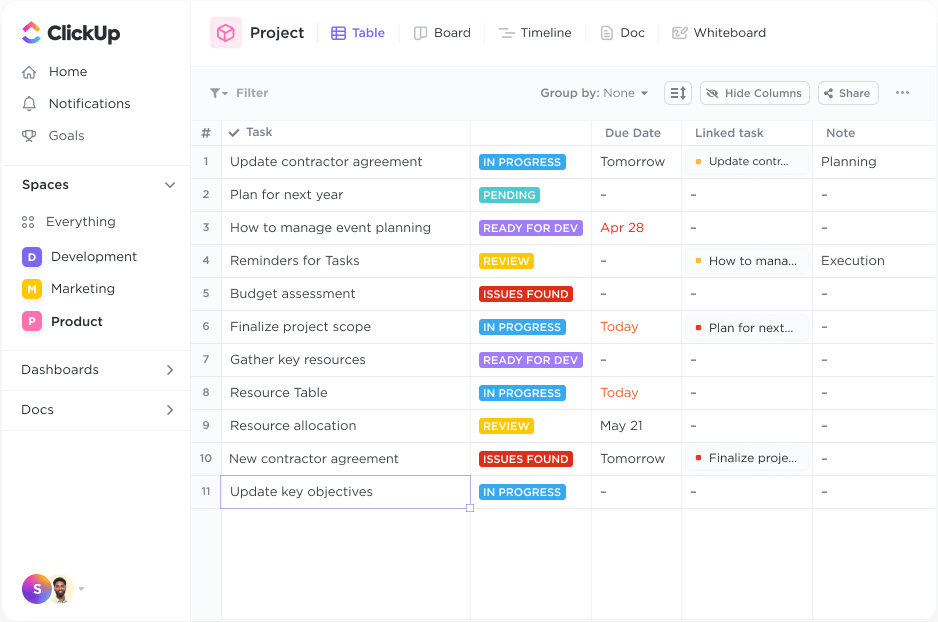
عرض الجدول في ClickUp للتحقق من عوامل اتخاذ القرار المختلفة
يمكن استخدام طريقة عرض الجدول لتتبع الخيارات حسب الحالة أو أي حقل مخصص. على سبيل المثال، إذا كنت تقارن بين أدوات إدارة المشاريع، يمكنك تعيين حقل مخصص لتوفر التطبيق مثل Android و iOS و Web، إلخ.
إذا كان الويب منصة مهمة بالنسبة لك، فيمكنك الفرز وفقًا لذلك وحذف غير المتاح منها. طريقة عرض التقويم مثالية لاتخاذ قرارات بشأن الوقت. يمكن استخدام مخطط جانت للجدولة. تعد طرق عرض عبء العمل والصندوق مفيدة للغاية في تخصيص الموارد القرارات، خاصة أثناء إدارة مشاريع متعددة .
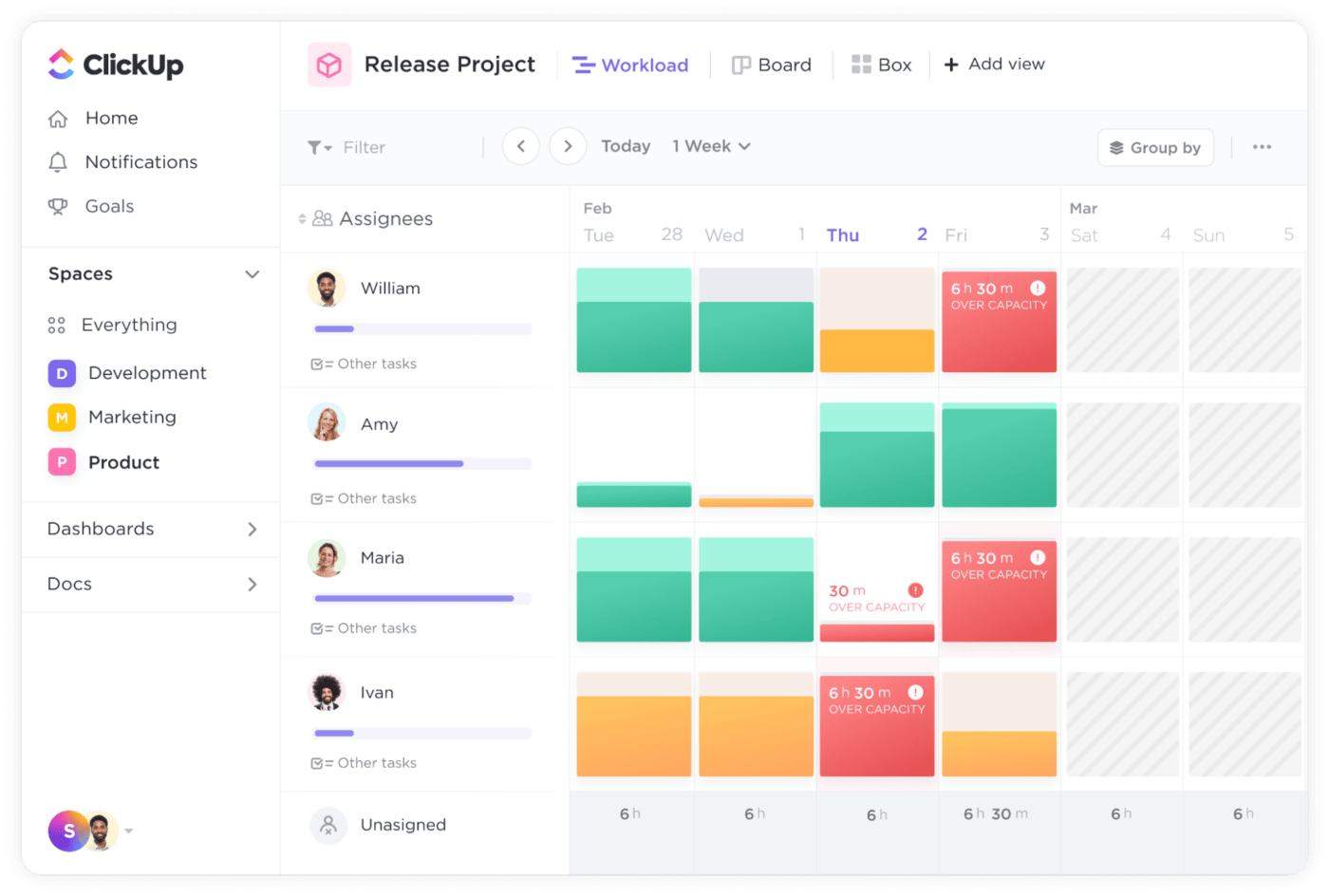
عرض عبء العمل في ClickUp لاتخاذ قرارات تخصيص الموارد
إذا كانت المشكلة التي تعمل على حلها تتطلب أسلوبًا مفاهيميًا، فأنت بحاجة إلى أدوات إبداعية. إن كليك أب السبورة البيضاء مصممة لهذا الغرض تحديدًا.
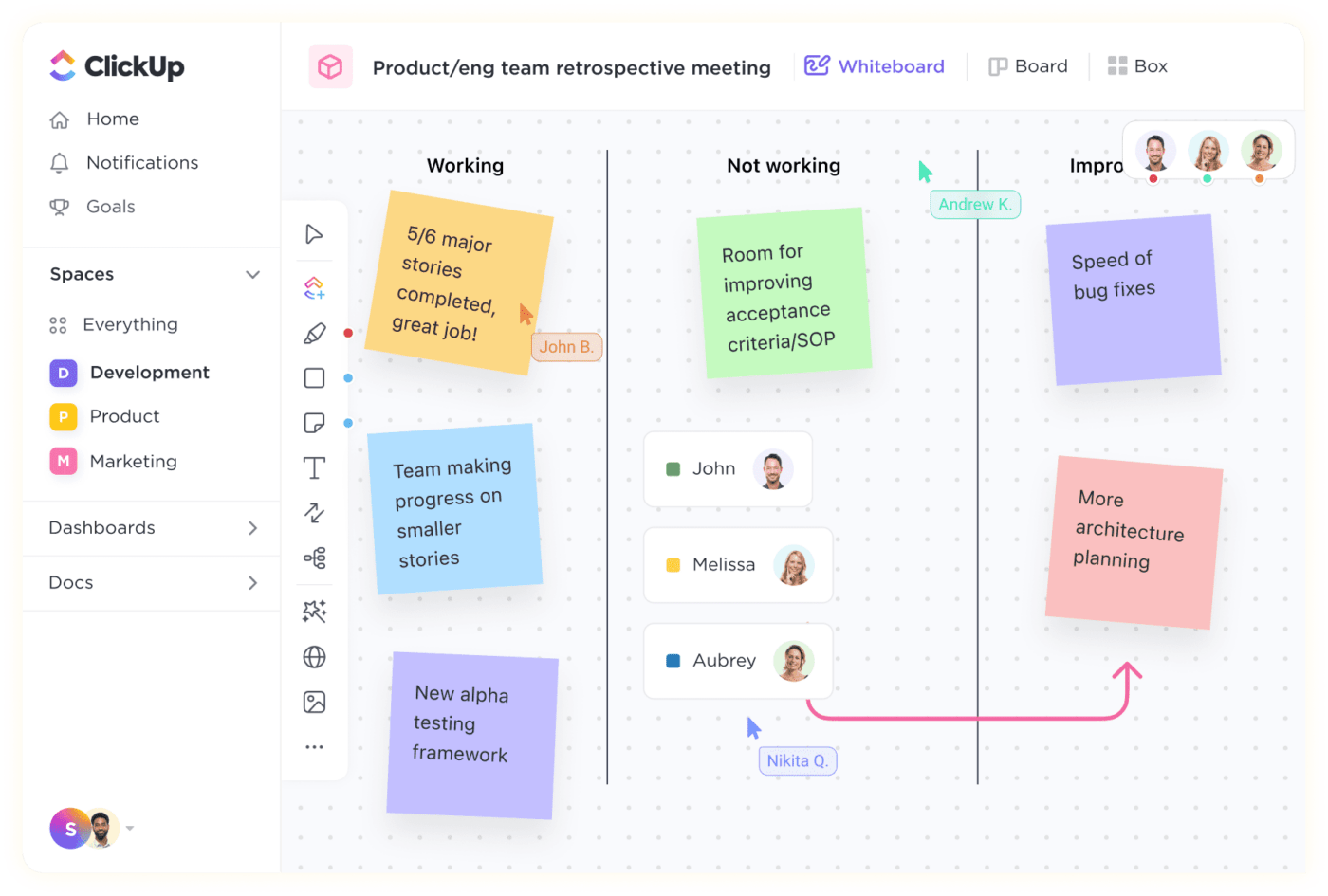
بناء سير عمل رشيق باستخدام ClickUp Whiteboard
يمكنك العصف الذهني على لوحة فارغة أو استخدام إحدى لوحات ClickUp العديدة قوالب صنع القرار . تتبّع أنشطة الجميع وأضف الملاحظات وتعاون في الوقت الفعلي لتجميع الفريق في مكان واحد.
نوصي بما يلي نموذج إطار عمل ClickUp لصنع القرار الخاص بـ ClickUp للبدء.
قد تكون عملية اتخاذ القرارات السلوكية معقدة. لكن ClickUp يمكن أن يساعدك في ذلك أيضاً. عندما تتعرف على فريقك، استخدم النماذج على ClickUp لجمع المعلومات والتفضيلات. إذا كان عليك إدارة توقعات العملاء، فهذه نماذج تقييم الاحتياجات ستساعدك على تحديد أولوياتها.
اتخذ قرارات أفضل في كل مرة باستخدام ClickUp
سواء كنت تتخذ ثلاثة مليارات قرار أم لا، فإن اتخاذ القرارات هو المسؤولية الأساسية لكل مدير. إن قدرتك على اتخاذ قرارات أفضل ستجعلك مديراً موثوقاً وفعالاً.
يحتاج صانعو القرارات التوجيهية إلى البيانات. وبصفتك تحليلياً، فأنت بحاجة إلى الرؤية. وكصانع قرار مفاهيمي، فإنك تعزز الإبداع. وبصفتك صانع قرار سلوكي، فأنت بحاجة إلى رؤى حول فريقك. ClickUp هو مكانك الوحيد للحصول على كل ذلك وأكثر.
يساعدك ClickUp على التقاط البيانات وتنظيمها وتحليلها بالطريقة التي تناسبك. تتبع باستخدام لوحات كانبان، وقارن مع طرق عرض الجدول، وقم بالقياس باستخدام التقارير/لوحة التحكم، وتعاون مع اللوحات البيضاء، واتخذ إجراءات باستخدام المهام، وغير ذلك الكثير! جرّب ClickUp مجاناً الآن !
